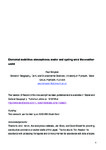Elemental mobilities: atmospheres, matter and cycling amid the weather-world
| dc.contributor.author | Simpson, Paul | |
| dc.date.accessioned | 2018-01-19T13:18:39Z | |
| dc.date.available | 2018-01-19T13:18:39Z | |
| dc.date.issued | 2018-01-18 | |
| dc.identifier.issn | 1464-9365 | |
| dc.identifier.issn | 1470-1197 | |
| dc.identifier.uri | http://hdl.handle.net/10026.1/10613 | |
| dc.description.abstract |
Everyday experiences of movement have become a central concern for social and cultural geography in recent years. Work here has begun to unpack the specific meanings, imaginaries and experiences that come to be bound up with mobile bodies and their practices. However, it has been suggested that more could be done to examine the material, elementary, molecular and physical aspects of movement which are significant to the experience of being on the move. Therefore, this paper explores the experience of cycling amid such turbulent ‘elemental’ materialities. Such ‘matters’ matter to cycling in the way that they (re)make both mobile environments and mobile subjectivities. Cyclists come to have quite immediate and intimate relationships with the material and ‘elementary’ aspects of the environments they move through given their relatively unmediated encounters with them. This paper draws on video-interview based research with 24 commuter cyclists in Plymouth, UK to consider cyclists’ experience of atmospheric conditions in terms of air’s force and air quality. From this, the paper reflects on how the experience of such ‘elemental’ matters might be significant to future research on and planning for cycling. | |
| dc.format.extent | 1050-1069 | |
| dc.language | en | |
| dc.language.iso | en | |
| dc.publisher | Taylor & Francis (Routledge) | |
| dc.subject | Atmosphere | |
| dc.subject | cycling | |
| dc.subject | materiality | |
| dc.subject | mobility | |
| dc.subject | video-interview | |
| dc.subject | weather | |
| dc.title | Elemental mobilities: atmospheres, matter and cycling amid the weather-world | |
| dc.type | journal-article | |
| dc.type | Journal Article | |
| plymouth.author-url | https://www.webofscience.com/api/gateway?GWVersion=2&SrcApp=PARTNER_APP&SrcAuth=LinksAMR&KeyUT=WOS:000483613700002&DestLinkType=FullRecord&DestApp=ALL_WOS&UsrCustomerID=11bb513d99f797142bcfeffcc58ea008 | |
| plymouth.issue | 8 | |
| plymouth.volume | 20 | |
| plymouth.publication-status | Published | |
| plymouth.journal | Social and Cultural Geography | |
| dc.identifier.doi | 10.1080/14649365.2018.1428821 | |
| plymouth.organisational-group | /Plymouth | |
| plymouth.organisational-group | /Plymouth/Faculty of Science and Engineering | |
| plymouth.organisational-group | /Plymouth/Faculty of Science and Engineering/School of Geography, Earth and Environmental Sciences | |
| plymouth.organisational-group | /Plymouth/REF 2021 Researchers by UoA | |
| plymouth.organisational-group | /Plymouth/REF 2021 Researchers by UoA/UoA14 Geography and Environmental Studies | |
| plymouth.organisational-group | /Plymouth/Users by role | |
| plymouth.organisational-group | /Plymouth/Users by role/Academics | |
| dcterms.dateAccepted | 2017-12-18 | |
| dc.identifier.eissn | 1470-1197 | |
| dc.rights.embargoperiod | Not known | |
| rioxxterms.versionofrecord | 10.1080/14649365.2018.1428821 | |
| rioxxterms.licenseref.uri | http://www.rioxx.net/licenses/all-rights-reserved | |
| rioxxterms.licenseref.startdate | 2018-01-18 | |
| rioxxterms.type | Journal Article/Review |


